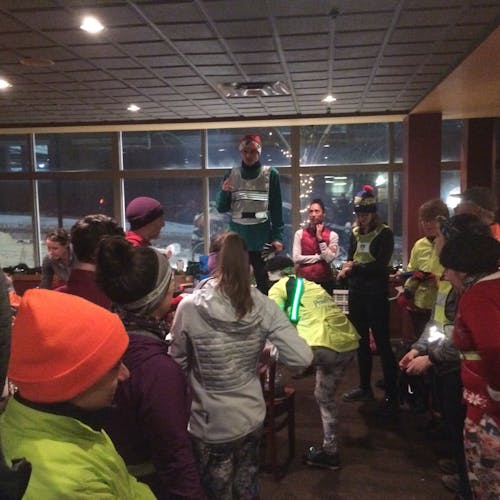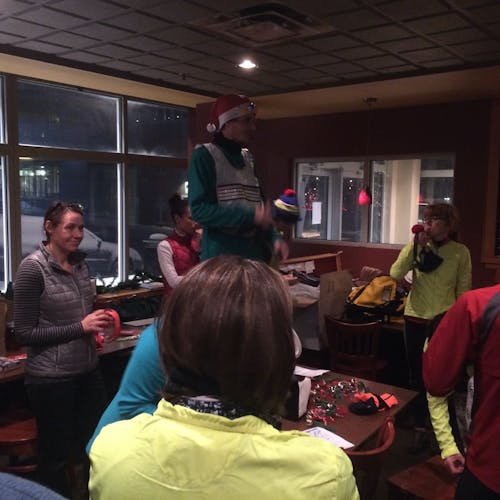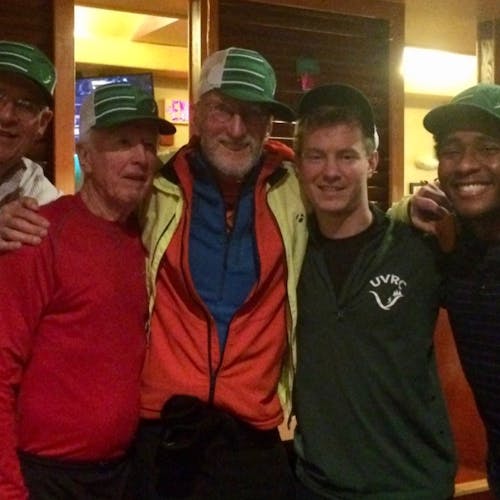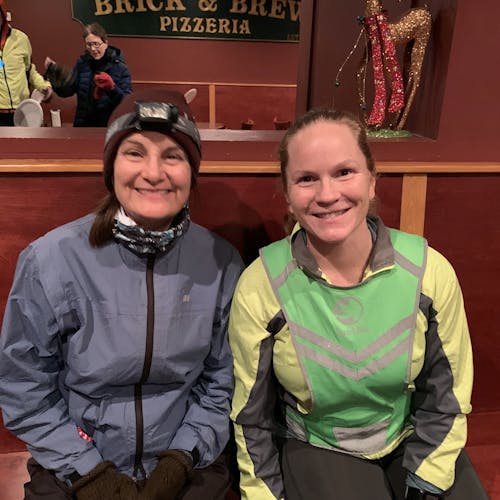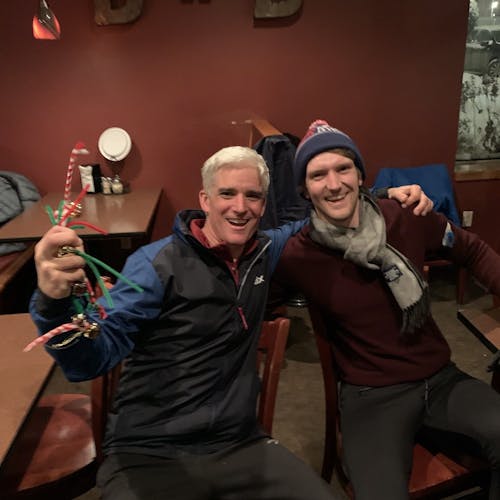January 2020 Newsletter
Note from the Editor
Welcome to the January 2020 edition of the Upper Valley Running Club newsletter — the first newsletter in the new decade! Keep your submissions coming — email newsletter@uppervalleyrunningclub.org.
Happy running!
Editor

Amanda Kievet
Trail runner, wool mill owner, web developer, quote unquote farmer.
Article Collection
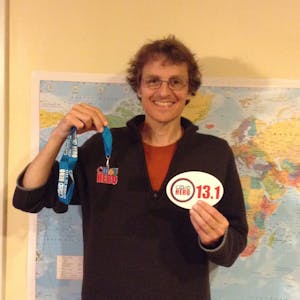
Geoff Dunbar
Former UVRC president, co newsletter editor, and UVRS coordinator.
A workout is where you make it
By: Dorcas DenHartog
Seasoned New Englander that I am, I knew from the sound of the sleet on my window that night that tomorrow would not be a snowblower day. Sure enough, I opened the door to the driveway that morning and nudged the crusted snow with my toe – no give. I gave it a hard whack with the back of my heel – and it dented. A little. Confirmed: This was not going to be down jacket-shoveling, like you see in the ads for Ski Utah. This was going to be a get-dressed-to-sweat workout. And I could not have been happier. Injured, I have not been able to run for several months, so exercise has been limited to core, physical therapy, and the elliptical. This was like the heavens had plopped down a gym in my front yard and said, ‘Who needs machines?! Circuit train on THAT!’
Fueled with a mug of strong, French roast coffee, I dressed as I would for a run in the cold rain. Armed with my one, trusty man-made tool, the shovel, I headed out the door.
Some of the tricks to a good driveway-shoveling workout: 1) Lift the shovelfuls with your knees – it targets glutes and quads. 2) Carry, don’t throw the shovel-fulls to the side of the driveway for added endurance. And 3) alternate your arms and throws – exercise both right and left arms, shoulder girdle, and transverse abdominus equally. Although track runners may choose just to use their outer/right side.
One and a half hours later I was done.
I followed it the next evening with a creative solution to the slippery mess that continued to fall, by shovelling a corduroy pattern, on the hunch that if the tires slipped on the frozen pavement they would ‘catch’ on the ribbons of shnow. (That’s Inuit for sh**tty snow).
And yesterday, as a gift to the mailman, I shovelled out my mailbox. Three days of frozen precipitation, super-compacted by freeze/thaw and the snowplows gave me another 45minutes of long-distance strength.
Now, because it’s not a workout unless it’s posted on Strava,I’ve been reviewing their training mode choices to see how best to enter my exercise. Multi-sport? What’s that? Cross-fit, maybe. But they’d sue me for misappropriating their brand. Obstacle racing, no, because it was just one obstacle – well, trillions of H2O molecules. It was Aerobic, but I visualize Jane Fonda and scrunchy socks and leotards and 1980s Top 40, not my Darn Tough socks and Mountain Hardware Gore-tex, with the growl of city snowplows and and chickadee songs in the background
I’m going to settle for Circuit Training. Meanwhile, I’ll ask our Strava-man, Lee Peters, about adding a Farm Boy strength icon to the choices. Data entry would include density of the material moved (snow, hay, manure, type and age of wood), distance moved horizontally and vertically, and maybe the length of the lever (pitchfork, shovel, or arms).
Meanwhile, here’s to winter exercising with a purpose, the way we used to do it.
Be a Pacer at Covered Bridges Half Marathon in June!
By: Rebecca Stanfield McCown
UVRC is excited to be providing the pacers for the event again in 2020, our 5th year providing pacers for this exciting event, and we will be looking for volunteers. What does it take to be a good pacer you ask? There are a couple things: 1) this isn’t your first rodeo- you are an experienced half marathoner and having run Covered Bridges before is a bonus, 2) you aren’t looking to set a PR- it is very important to select a pace that is slower than your race pace and you are certain you can maintain, and 3) you come second- this race won’t be about you but about helping those around you reach their goals.
As a pacer you get to run the race for free, a special pacers tech shirt, and the awesome experience of helping other runners reach their goals. Pacers are also encouraged to attend the question and answer session the day before the race as well as the pasta dinner the night before. Prior to race day, we will have a pacer meeting and opportunities to get out on the course with your co-pacers to develop a strategy, get comfortable with the pace, and get to know each other if you don’t already.
We will be looking for 2 pacers for each group and a few “drifters” that can be on hand and ready to run when we have to fill in spots last minute. That means about 30 pacers in all. That is a lot of people!! If you haven’t had an opportunity to pace yet, I highly encourage you to give it a shot. It is a very rewarding experience. You also get free entry into the race, a pacer shirt, and to carry an awesome sign while you run!
How do you become a pacer? Fill out the Pacer Application https://forms.gle/pL8WF2wjwXXzjpJZ6. Last year we were able to accommodate almost everyone that volunteered and I expect the same will be true this year! UVRC members get first crack at pacing times and then the offer goes out to other running clubs to fill in the gaps.
Paces will be: 1:30, 1:35, 1:40, 1:45, 1:50, 1:55, 2:00, 2:05, 2:10, 2:15, 2:20, 2:25, 2:30
Runner Profile: Timothy Smith
By: Scott King
Name: Timothy Smith
Town: Hanover
Where are you from originally and what brought you to this area?
I was born in Wisconsin but grew up in upstate New York. I like to say I am a resident of the 42-parallel. I came to the Upper Valley because my wife is a professor at Dartmouth.
What do you do professionally? I am a physicist and an Adjunct Professor of Physic at Dartmouth.
How long have you been running? Since the day after I learned how to walk.
How long have you been running competitively? I ran in high school and college and for two more years (1974-1984) and then stopped for graduate school and to raise a family. I came back to running in 2012 after a 28 year hiatus.
Why do you run? When I started running in my youth, it was to get in shape so I could be a better hiker. Then I soon realized that because of running I had no time the hike. That trend also seems to be true in my second career.
Recent memorable moment while running? I was running with some UVRC people, getting ready for Covered Bridges. We were on River Rd near Taftsville, doing about a dozen miles or more. The air was full of truly massive snowflakes, the sort of which look like goose down. It was one of those perfect runs in which you plan on eight miles, but you keep adding more because the legs feel like you shouldn’t stop them; and we negative split the whole way.
Best athletic accomplishment and why? I took 2nd place at the New York State Collegiate Championships (D-III) in the 3000m Steeplechase. I do think my greatest physical race was a relay from Eugene, Oregon to Corvallis. 50 miles, 5 runners each running 5 legs of 2 miles. In the first 3 legs I set 3 PRs for the two mile. The last two legs have stories of their own.
If you like to race, what is your favorite race distance? Why? 5k. It’s fast, so the pain is short lived.
If you like to race, notable race moment or most memorable race? Missing my footing on the first steeplechase barrier my last collegiate race at Penn State and falling into the water jump. Then doing essentially the same thing two years later at Hayward Field. I was also part of a 1,776 mile relay to celebrate the Bi-Centennial.
Training partners? Anyone who shows up on Saturday morning and Tuesday TNT. That means I have probably logged more miles and have had more fun with Geoff Dunbar than anyone.
Cross training activities? In the winter, cross-country skiing. In the summer I hike, bike, canoe and kayak, but that is just entertainment.
Favorite local running route? Starting in Hanover, cross the river to Norwich, north on River Rd, west on Goodrich-Four Corners. Return on Union Village road. There is a bunch of climbing from the river to the top of Union Village road; so after that the second half is really easier.
Favorite post run treat? On really hot days, I have been known to end my run by swimming in the Connecticut River.
Strangest place ever run? When I was living in Oregon once, I got tired of doing intervals in the rain. Near where I lived, was a parking garage, which emptied out in the evenings. It was nearly 400 meters around a lap inside the garage, so I did intervals there. For a recovery I would jog up the ramp, and do the next interval on the next level.
Any notable streaks or other unusual running events? A year out of college, a friend of mine and I talked each other into going to Eugene Oregon to train. We also committed to not missing a day, so for 440 days, until I bicycled out of Eugene, I ran every day.
What made you start running? My father and older brother both ran so I was aware of running, but I considered myself not very athletic. Then in 8th grade (3rd form) I was living in England and we worked on the Duke of Edinburgh Award (like the Presidential Fitness program) in gym class. I won every event from 800m to 3000m. I had found my calling.
I also wanted to be a great hiker.
Who is your running “idol”? Roger Bannister, Sebastian Coe, Henry Rono, Mary Decker. I date myself with the list (especially Banister). But now I run with a different focus than I did in the 1970’s and 80’s. Actually it was Coe’s work in this decade which got him on this list (beating out Steve Ovett).
Are your reasons for running now the same or different than the reason you first started? Some reasons are the same; I am competitive, I want to be in condition to hike and it is my only social activity. Some reasons have changed; I used to need to prove I could keep up with my brother, I now run because being out there brings me happiness.
Why did you join UVRC? Nancy Dunbar told me I should join. On the second day of my come-back training (after a 28 year hiatus) Nancy slowed her gazelle-like pace to run with a jogger and told me about the club. She then disappeared into a cloud of mist (it was rain). As she sprinted ahead of me, I too wanted to be a gazelle. So after a few weeks of training I showed up at Omar and Bob’s and have been coming ever since.
The dream of gazelle is still out there some place.
Ever run in a costume? One year (1977?) near halloween my high school team had a costume run. I dressed as the FTD florist man. Which meant dressing as Mercury (winged feet and hard hat!) and carrying a plastic bouquet of flowers.
The only running shoe for me is the ones I am wearing today.
Ever been injured? How did it happen? Too often. Slipped once in college and messed up my knees. Then there are injuries that I have no idea why they happened.
Hot or cold weather runner? I much prefer cold, but will admit that on those coldest of Upper Valley days the first five minutes can be pretty challenging.
Morning or evening runner? Generally an evening runner. There have been some uniquely golden mornings too!
What is your motivation? Many. To be in shape to hike. To beat anyone who tries to challenge me in the last mile of a race. To be outside on those fantastically beautiful days were if you stood still you would be miserable, but if you are running, life is cozy and warm.
I run therefore I am alive.
How did you become interested in running? It was something I was pretty good at in gym classes.
What is your favorite race? The Main Street Mile. Talk about a short a sweet race! As well, an evening in May can be really pleasant! The mile was also my primary event in high school, and the event ran by my “Running Idol” (see above) Roger Bannister.
Favorite running book/film? Chariots of Fire. One of the minor characters runs the steeplechase and ends up caked with mud and cinders. I can relate to that.
What does your daily workout consist of? Daily workouts change a lot, but the weekly cycle in mid-season looks like; Sunday – long & easy (12 miles). Monday rest. Tuesday TNT (intervals). Wednesday – short & recovery. Thursday – Tempo. Friday short or rest. Saturday – long with UVRC -ending at Lucky’s. Usually 35-40+ miles.
How about favorite work out? 12 x 400m. To do it right I must already be in good shape. So sometime 8 to 10 400’s instead. But if I can do 12, and do them well, I am very, very happy, (and exhausted!)
What is your diet like? Yes, I like all food. Generally I eat a low-meat diet, but I am not a vegetarian. I also generally can’t eat anything for a few hours before running.
If you could run with anyone, who would be the person? It would have been Roger Bannister. Now I would pick Sebastian Coe.
Additional input or comments? When I was a year out of college I quit my job and with a friend moved to Eugene Oregon to run (1983-84). The first thing I learned was that there a lot of people who want to be champions, and a large number of those are better then me. I ran very well, but also discovered what my place in the running world really was. I would do it again, and recommend the experience, even if there is little chance of great success. I learned a lot – and also had a great time losing to really fast runners.
People to mention?
What about your coaches? My first coach, John Izzo (high school), somehow inspired a cloud of school-boys and -girls to work incredibly hard. I think we were ignorant about how hard we worked (24 x 440 yrd with a 1 minute recover was a common workout). But we were also incredibly successful. The connection between hard work and success was never so clear.
My second coach (College cross-country) I don’t think really understood running, and so I’ll skip him.
My third coach, Richard Ceronie (College track), showed me that their might be a more intelligent way of training. Weights, stretching, technique and even recovery have a purpose. He also believed in me more then anyone else. Recently I’ve had contact with him, and he now has a career of experience I want to tap into.
My most recent coach was Tony Ruiz from Central Park Track Club. He set goals for my return to running, but also demonstrated the unique challenges of building a club running program. Clubs have a wide range of talent, expectations, and ages. Tony managed to juggle that well.
What else should the club know about you?
Inspired by the hard work I’ve seen from UVRC runners I went and spent a few days at the USATF coaches school. I believe in this club almost as much as Ceronie believed in me.
Aside from running, what are your hobbies?
Hiking, paddling, cross-country skiing, gardening, reading, writing & traveling.
Full Marathon Versus a Half Marathon
I would like to better understand how people approach the commitment of a full marathon versus a half. Do you simply train 2x as much? How else have people adjusted their schedules/workouts/diets to prepare?
— Ryan Scelza
Dorcas DenHartog
What I can add is that my first marathon was eight months after giving birth. I stayed fit through birth, and then took three months off:
- Because I had a Caesarian, and
- Because women’s ligaments remain loose for three months post-birth and women should NOT (re)enter planned, training, scheduled, hoped for training until that time, and
- Most importantly, I had a male/father/friend/triathlon coach, Hank Lange, tell me of his wife’s experience. She started training too soon after birth and injured herself, setting her back for a MUCH LONGER TIME.
Message: Patience. Be With Your Child Now. Was his message. Whether you are a father or mother.
The athlete/you and the mother/child- you will forever benefit from this focus. Do not waver. If you feel the need, go for a walk with a friend, ask for babysitter/family help, go to a yoga/tai chi/spine class/water workout.
You’re moving from 1/2 to full marathon. It’s the same idea. The body is a Garden – you only have so much time and energy to plant (time/energy/physical and mental capacity). You cannot plant twice as much, because you don’t have twice as much of any of that.
Make the best of what you have. The other coaches will tell you how to do that.

Dorcas DenHartog
Dorcas DenHartog coaches cross country running at Hanover High School and summer track for UVRC
Carly Wynn
This is a good question! I suspect approaching a full marathon is intimidating to many for this reason. It’s easy to see the progression from half to full marathon as linear, but it’s exponential. The jump in race distance is much larger than the jump in training volume. Training volume may increase a bit, but not double. However, there is one thing that might double…
It’s not that you need to be doubling your training time per week, but you may find yourself doubling the time period you’re training with a focus on that particular race. That extended training period will help cover the primary increase in training load: the length of the long runs. You shouldn’t increase the rate at which your weekly long runs are getting longer; you should start training earlier for a marathon and increase your weekly long run length at the same ratio that worked for your half marathon. You don’t need to be twice as fit to run a marathon. You do need to be able to run 26 miles. So yes, ideally long runs will eventually get longer.
Changes to other components of training will vary between athletes. Some athletes may prefer, and may have the time and resources, to increase the length of most training runs. Some may want to see an increase in cross training, in order to increase aerobic training volume while mitigating the increased risk of injury associated with higher mileage. Alternatively, some athletes may choose to incorporate more intensity (interval) training at paces comparable to half-marathon pace. Note that increases in training volume and increases in training intensity should be treated as equally taxing on the body, so as a blanket statement I wouldn’t recommend an athlete increase both at the same time. Athletes who have competitive goals in their marathon may opt for the increased intensity, in an effort to increase lactate threshold and ability to perform at high aerobic output. Athletes looking to complete a marathon will probably benefit more from a slightly increased aerobic load over a long training period, perhaps with some specific intervals as prescribed by a coach.
Also keep in mind that the resources your body uses to prepare for a marathon are not limited to training. You will also need slightly more food to fuel the slightly longer long runs, you’ll need to practice eating during those long runs since you will certainly need to eat during your race. You will also need more recovery time and sleep. Not twice as much, again, but a bit more, as demanded by the body: if you’re hungry, eat a bit more, if you’re tired, sleep a bit more. If you’re not already in a good routine of post-workout stretching, foam rolling, and healthy snacking, and if you’re not already sleeping enough on most nights, your first order of business in preparing for your marathon will be getting those ducks in a row.
Keep your shoes in good working order. Any mileage increase just elevates the risk of injury, and nobody wants to train for 6 months for a marathon only to get injured in the last couple weeks. If you’re not already taking advantage of a strength training program or prehab routine, I recommend talking with a PT, coach, or trainer about that as well. There are probably a couple quick exercises you could be doing to help ward off any injuries you might be prone to.
If you’ve successfully prepared for and executed a half marathon, you’re likely very capable of doing the same for a marathon. It will require more attention to the little details of self-care, a longer period of training, and will require a slightly increased training volume and/or intensity, but not double. And remember, there are a ton of good resources out there to help keep you healthy and make sure you’re getting the desired effect from the training you’re putting in, so ask for input and assistance as needed when you decide to go for that marathon!
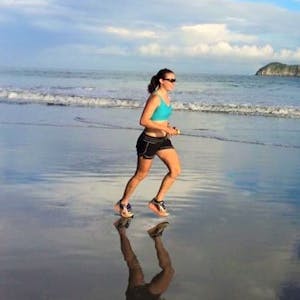
Carly Wynn
Carly Wynn is a personal coach at www.CarlyOutside.com, and can be reached at Carly@CarlyOutside.com
Laura Hagley
Here are some of the rules that I follow in marathon training. I think it’s important to avoid becoming too prescriptive, since each individual will find what works for his/herself. So, here I lay out what has worked for me, with no claims to prescribe the exact plan to others.
1. Run lots of miles. Some research shows a significant benefit from a peak of at least 50 miles/week.
2. Peak mileage: increase peak miles by no more than 10 miles per week, per year. For example if 50 mi/week is peak mileage one year, then next year jump to a peak of no more than 60mi/week.
3. Running two times/day is easier on the body to achieve a higher mileage. For example, on weekdays I run my typical 12miles; 8ish in the early morning, and 4ish easy at noon.
4. Decide on the day’s goal, whether a quality day or easy day. Quality = Long or intense runs. Favorite and most critical intensities = Marathon pace, Threshold pace, 10k pace. Easy = 60-90 seconds/mile slower than marathon pace.
5. Recover! After a quality day, leave at least two easy days before the next quality day.
6. Rest. Although I rarely take a day off of running, I do strive for 8 hours of sleep per night. I also take a complete day of rest from all of life’s normal work/stressors once per week.
7. Don’t get injured :)! Hard and fast rules for me – If there’s a niggle at an easy pace, don’t do a quality session. If there’s a niggle walking, don’t run. If gait is altered from any niggles, stop.
8. Nutrition – Avoid food from factories whenever possible. I eat a banana + almond butter before a morning intensity session, but otherwise run without stuff for anything at an easy pace. When racing, I use Maple Untapped every 5 miles for both half and full marathons.
9. Don’t run the marathon before the marathon – 3 hours is long enough for any single session prior to race day. If concerned about the end of the race, consider adding intensity to the end of the 3 hour run (see #10).
10. Do include intensity within long runs toward the last 6 weeks of training, only after the long run (20 miles or 3 hours) has been achieved at an easy pace. For example, instead of a 22 mile long run at an easy pace, one of my favorites from Jack Daniels’ Running Formula is 2mi Easy, 4 miles threshold, 10 miles easy, 4 miles threshold, 2 miles easy. Likewise, instead of a 17 mile easy run, another favorite is 2 miles easy, 13mi at Marathon pace, 2 miles easy. You get the idea… if we only run long easy pace in practice, we will be limited to easy pace on race day.
Above all, do whatever floats your boat. The reason I lace up my sneaks is for the present joy of running, breathing, exerting, socializing, waking up with the birds, and more. No matter how big of a goal is achieved on race day, the most joy may just be in the daily act of preparation and anticipation. Enjoy every step!

Laura Hagley
Laura Hagley, DPT, CSCS, EP-C runs competitively for Millennium Running Club. She placed 25th at 2016 Olympic Trials, and competed in the Elite Women’s Wave of the 2016 Boston Marathon. Professionally, Laura is the Director of Ancillary Services and Physical Therapist at Valley Regional Hospital in Claremont, NH. For questions, please email laura.hagley@vrh.org.
Jim Burnett
After successfully running a half marathon, runners often look to the marathon for a bigger challenge. Many consider the marathon to be the gold standard of endurance running. Blame it on Pheidippides and his heroic 26+/- mile run from Marathon to Athens to declare victory over the Persians. That he dropped dead after uttering, “Joy, we win!”, only makes the marathon “badge of fitness” all the more alluring. Just ask Oprah or “Backwards Billy”, the Achilles International physically challenged athlete who has completed multiple marathons by sitting in his wheelchair and propelling himself backwards using his one functional leg. Suffice it to say, the bigger the mountain, the better the view, the sweeter the reward. The commitment to the training regime required for a half marathon and marathon is similar in its basic structure but differs greatly in terms of scale and degree. If you are young and strong you may be able to “cheat” the half, but as many who have tried will sheepishly admit, “You can’t cheat the marathon.” Proper training requires a big investment of time and energy, but the hard work and long hours will pay even bigger dividends in the long run.
Here’s how to get it done. If it’s your first marathon, you should follow a training plan of about 6 months duration. The first 3 months should focus on building up your physical and mental strength and endurance foundation by gradually increasing your weekly mileage to about 35 miles per week. These miles should be run at a very slow pace for you and include intermittent walking intervals throughout the buildup period. If you are a newbie to the marathon, use the first 3 months to get to know your body. Don’t rush this process – become aware, pay attention and soak it in. You will learn a lot about how your body works and its amazing capacity for adapting to physical and mental stress. Open your mind and feel how your body works – what feels good, what hurts. Let discomfort and pain be your friend and your guide. Every “body” is different. Get to know yours. Pay attention to your footfalls, breathing and heart rate (HR) and use them as a measure of your effort. Monitor your cadence and stride length. Feel how the tendons and muscles your feet absorb the impact of your footfalls. Remind yourself to relax and enjoy the rhythms of “the body in motion.” The cardinal-rule for the first three months is to apply stress to your body incrementally and follow up each workout with an equal measure of rest-recovery time.
The 3-month foundation building period is a good time to reassess your current lifestyle. It affords you the opportunity to reorganize your daily and weekly schedule, to reevaluate what you eat and drink to fuel and replenish your body and reconsider how well and how long you should sleep and rest. Many runners have successfully integrated marathon training into major lifestyle changes. If you can stick to a 6-month training program and run a marathon with a smile on your face, it may be a turning point, it might change your life forever. Read up on and experiment with various eating-fueling and hydration regimes during your training weeks and on your weekend longer run-walks. Smart nutrition, proper hydration, choosing the right running shoes and ample rest-recovery on a daily basis are essential if you want to succeed on race day. Your primary goal during the 3-month build-up is to become accustomed to being on your feet and moving comfortably for longer and longer periods of time. It’s not about speed, it’s all about building strength and endurance – both physically and mentally and discovering how building up your strength and endurance can, in turn, build self-confidence. As you become a smarter and more efficient runner you will start to believe you can do it, yes you can run a marathon. It is said that the marathon race truly begins at the 20-mile mark and you need to be patient – you have to wait until the right moment “to pull the trigger” and “unleash the beast.” This applies to elites and newbies alike. It can also be said that the path to a successful marathon takes lots of long hours and many miles of training before you begin to truly believe you can run 26 miles and finally whisper to yourself, “Yes, I can do this.” The first 3 months of preparation is all about running slowly, self-introspection, cleaning up your act, building self-confidence, finding your running groove and believing in yourself.
If you are already running 35+/- miles a week and want to ramp-up to the marathon, “Welcome to the party.” You have only 3 months to go! At this point all runners, newbies and veterans alike, need to ask themselves, “Do I just want to complete the race without killing myself and maybe speed up a little bit for a strong finish in order to cross the finish line with a photo-op-smile on my face,” or, “Do I want to run as fast as my body will let me, zoooooooooooom…no matter how much it hurts, Grrrrrrrrrr!” Regardless of where your personal aspirations sit on this continuum, your 3-month ramp-up to the race will require even more restraint and patience than the first 3 months of preparation. You need to stay smart and focused in order to toe the line healthy, fit and fresh.
Just like the first 3 months of foundation building, ramping up for the big race during the last 3 months calls for carefully measured doses of added stress on the body followed by equal measures of recovery time and rest. It’s tempting to run too far, too fast, too soon in the ramp-up to the race. Don’t do it, and remember, “You can’t cheat the marathon.” You will only end up injuring yourself and throwing 3 months of hard-earned foundation building out the window. Be smart, be strong, be patient. Your major goal for the last 3 months is to improve your running efficiency (running faster while using the same level of effort) by training most of the time at or below your maximum aerobic function (MAF) threshold. (For more about MAF see Dr. Phillip Maffetone’s book, 1:59: The Sub-Two-Hour Marathon is Within Reach, 2014.) Unlike shorter sprint races run almost entirely anaerobically, long distance races (10K and up) are run almost exclusively aerobically. In fact, according to Maffetone, 98% of a marathon is run aerobically, that is to say, it is run at a pace in which the runner is cruising along at or just below his MAF threshold = He can breathe easily and carry on a casual flowing conversation.
During the last 3 months, do 3 quality workouts per week. On Tuesdays do a long (800 meters +) interval workout on a 400-meter composite (spongy) running track or other flat, soft surface. On Thursdays do a tempo, fartlek, progression and/or hilly run. (For tips on pacing and threshold running for all workout types, see Jack Daniels’ book, Daniels’ Running Formula, Third Edition, 2013.) On Saturdays or Sundays do a longer, slower distance run-walk. (For tips on applying the Run Walk Run Method for weekend longer runs marathon training, see Jeff Galloway’s book, The Run Walk Run Method, 2013.) Reserve the other 4 days of the week for active recovery workouts, including biking, swimming, walking, hiking, elliptical machine and Ellipti-GO, core strength training and really slow walk-jog-walks. The purpose of active recovery exercises is to rest while stimulating blood circulation through low-impact, high-RPM spinning exercises and casual swimming, walking, hiking, etc.
The goal for your quality workouts is to gradually raise the level of stress during Tu/Th/Sat-Sun workouts and follow up on recovery days with equal amounts of soft rest-recovery activities and longer daily sleep-rest duration to allow your body to heal itself and, in turn, improve your running efficiency. Cap quality run overreach mileage (efforts requiring HR above MAF) during quality workouts at 8% of total weekly mileage. Remember that overreach can result as a function of either increasing your pace and, consequently, HR over a shorter distance or as a function of running longer distances over longer periods of time. A good rule of thumb is for 80% of your weekly mileage to consist of the combined distance you run at or below MAF while the remaining 20% of your weekly mileage should be run at an effort below your MAF. The more fit and efficient you become, the more aggressive you can be during your quality workouts without breaching your MAF threshold. But, it’s always better to be safe than sorry. Be mindful of Hypocrites and “Do no harm.” When in doubt, back off and avoid injuries. A good way to gauge whether or not you are overdoing it is to chart your resting heart rate (HR) day-to-day. Running watches with wrist HR sensors or devices combined with chest-strap sensors, apply algorithms that can measure your resting HR for you. Of course, you can always take your own pulse when you get out of bed in the morning. The method doesn’t matter and beats per minute (BPM) are not especially useful individually, but collectively and over time they define trends. If your resting HR goes up 3-5 BPM on the morning of a recovery day following a stressful quality workout the day before, that’s to be expected and it’s okay as long as your resting HR comes down again in equal amounts by the morning of your next quality workout. If your resting HR doesn’t return to its baseline, reduce the stress load of the quality workout that day or skip the quality workout session altogether.
If you were to draw a graph of the volume of your total weekly workout exertion (a combination of overall exercise time, mileage and effort) over the course of your 3-month ramp-up to race day, it should resemble a Bell Curve tilted a bit to the right, with its peak coming at the end of the second month. For the first 2 months your total weekly volume should gradually increase, then, during the last month, it should taper off. The idea is to gradually improve your cardiovascular fitness, running efficiency, strength and endurance during the first 2 months, then maintain them for 3 weeks, while backing off a bit, and then, finally, backing off dramatically during the last week (tapering) to rest and refresh your legs for the big race. Runner’s World Magazine, Daniels, Maffetone, Galloway and others all offer useful marathon training plans that can be adapted to the basic model recommended here. Your success depends on the strength of your commitment to listen to your body, show restraint and be patient.
Good advice to up-and-coming divas is to go ahead and sing the classic hit songs of the past and give it all you’ve got. But, in the end and most importantly, you need to make it your own. So, Ryan, my advice to you is to use and adjust this basic marathon training plan model and make it your own. Breathe deep and relax, open up all your senses, listen to your body, use pain as a guide, eating “real food,” feel yourself becoming strong, efficient and fit, build self-confidence, trust your training, believe in yourself, and then smile and fly.
Zoooooooooooom…Grrrrrrrrrrrrr…

Jim Burnett
Jim Burnett is a long time runner and former President of the Upper Valley Running Club


